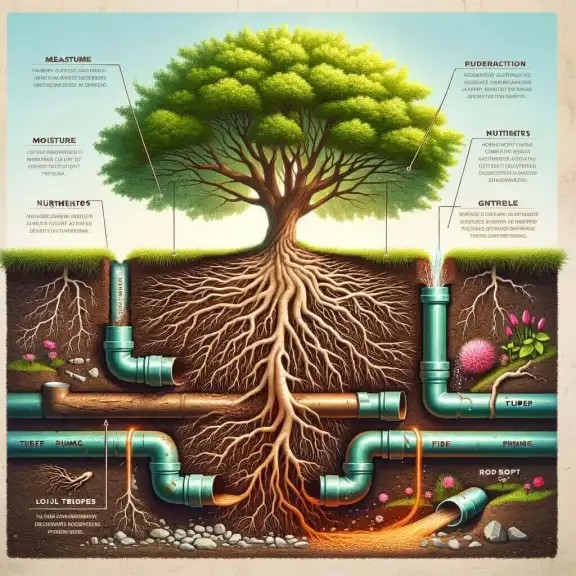Tree roots can cause significant problems for your plumbing system, especially when they invade underground pipes for water and nutrients. Over time, these roots can grow into pipes, causing blockages, leaks, or even complete breaks in the plumbing system. Understanding how tree roots impact your pipes and how plumbers address these issues is crucial for maintaining a healthy plumbing system and preventing costly repairs. We will explore the ways tree roots interfere with your plumbing in Toronto and the methods plumbers use to fix the damage effectively.
How Tree Roots Invade Plumbing Systems
Tree roots are naturally drawn to sources of moisture, and underground pipes provide a consistent water supply, especially if there are small leaks or cracks in the pipes. Roots from nearby trees can penetrate these tiny openings, gradually growing inside the pipes and expanding as they seek more water. Over time, the roots can cause blockages by filling the pipe and preventing the flow of water or waste. As the roots grow, they can also pressure the pipe walls, leading to cracks, breaks, or even complete pipe collapse. This invasion can lead to significant plumbing issues, including backups, slow drains, and unpleasant odors. Once tree roots have entered a plumbing system, they can be difficult to remove without professional intervention.
- Identifying Signs of Root Invasion in Plumbing
There are several signs that tree roots may have invaded your plumbing system. Homeowners may notice slow-draining sinks or toilets, indicating a blockage caused by roots growing inside the pipes. Gurgling noises in the pipes, frequent backups, or a sudden drop in water pressure can also point to root infiltration. In some cases, the roots can cause damage to the sewer line, leading to sewage backups in the home or yard. Additionally, homeowners might observe wet spots or sinkholes in the yard, which could indicate underground pipe damage caused by root growth. Recognizing these early warning signs can help homeowners address the problem before it leads to more severe plumbing issues.
- The Role of Plumbers in Diagnosing Root-Related Plumbing Problems
When tree roots invade a plumbing system, diagnosing the problem accurately is essential for determining the most effective solution. Plumbers use various diagnostic tools to identify the extent of the root intrusion and locate the affected areas. One common method is a video inspection, where a small camera is inserted into the pipes to provide a real-time view of any blockages or damage caused by roots. This allows plumbers to pinpoint the exact location of the problem without having to dig up large sections of the yard. In some cases, plumbers may also use specialized equipment to detect leaks or breaks in the pipes that may have been caused by root pressure. Once the problem is diagnosed, the plumber can recommend the appropriate method for clearing the roots and repairing the damage.
- Methods Plumbers Use to Remove Tree Roots from Pipes
Plumbers use several techniques to remove tree roots from plumbing systems. One common method is using a mechanical drill or rooter machine, which cuts through the roots and clears the blockage from the pipe. This is a quick and effective way to restore water flow, but it may not provide a permanent solution if the roots continue to grow back. Another option is hydrojetting, which uses high-pressure water to blast away the roots and clean the inside of the pipes. Hydrojetting can remove roots and other debris from the plumbing system, providing a more thorough cleaning. In cases where the roots have caused extensive damage to the pipes, plumbers may need to dig up the affected section and replace the damaged pipes. This is often necessary when the roots have broken through the pipe walls or caused significant structural damage.
- Preventing Future Root Invasion in Plumbing
Once tree roots have been removed from the plumbing system, taking steps to prevent future invasions is essential. One way to reduce the risk of root growth in pipes is by using chemical root inhibitors. These products can be applied to the plumbing system to create a barrier that discourages roots from growing into the pipes. Another preventive measure is regularly inspecting and maintaining the plumbing system, addressing small leaks or cracks before they attract root growth. Homeowners can also take proactive steps by planting trees and shrubs safely from the plumbing system, minimizing the likelihood of root intrusion. Homeowners can protect their plumbing from future root-related issues by working with a plumber to implement these preventive measures.
Tree roots can cause significant damage to your plumbing system if left unchecked, leading to blockages, leaks, and costly repairs. We will explore how tree roots invade underground pipes, the signs of root infiltration, and how plumbers remove roots and repair the damage. Plumbers can effectively restore the plumbing system by diagnosing the problem early and using tools like mechanical augers or hydrojetting. Preventive measures, such as chemical root inhibitors and regular maintenance, can also help prevent future root invasions. Protecting your plumbing from tree roots ensures a healthier system and reduces the risk of costly repairs in the future.




